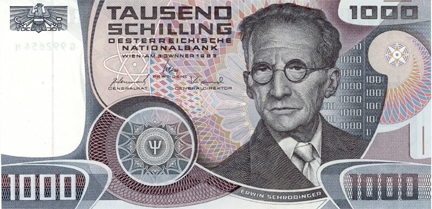Erwin Rudolf Josef Alexander Schrödinger
Erwin Schrödinger is known primarily for his work in physics and in particular for contributions to quantum statistics and wave mechanics. He proved, for example, that radioactive decay is statistical in nature. In 1935 he proposed his famous paradoxical "thought experiment' known as Schrödinger's cat.
While Einstein was initially enamored with Schrödinger's work -- describing his work on wave mechanics as springing from "true genius" -- the two later had a falling out. Indeed, Einstein increasingly rejected the statistical characterizations of quantum mechanics that are now widely accepted as correct.
While he was a Catholic and thus not personally subjected to Nazi persecution, by 1933 Schrödinger had decided he could no longer live in a country that persecuted Jews and left for Oxford. He was offered a position at Princeton but the fact that he openly had two wives, one of whom was married to his best friend Hermann Weyl, did not sit well in either Princeton or Oxford. Ultimately he took a position in Graz, Austria where he was caught by the German anschluss. In order to retain his freedom, he wrote a letter purporting to support the Nazi cause, a letter he was to regret for the rest of his life. Despite the letter, the Nazis arranged for his dismissal from the University of Graz. Schrödinger once again fled Germany, first to Rome and eventually to Dublin where a new Institute for Advanced Studies was being founded.
Schrödinger remained in Dublin (where he had an additional two daughters by two different Irish women) until his retirement in 1956 when he returned to Vienna. His later researches continued in quantum physics, but also included biology and metaphysics.
Schrödinger won the Nobel Prize in 1935 for his work in quantum physics. Austria honored him by placing his image on the 1000 schilling note.

Died: 4 Jan 1961 in Vienna, Austria
The premiere site for biographies of mathematicians on the web is at The University of Saint Andrews in Scotland; this is the primary source of the information in these short biographies. Some biographies used additional web resources as noted in the biography.
The postage stamp images came from a wonderful site on mathematicians on stamps maintained by Jeff Miller, a mathematics teacher in Florida.
The Free Internet Encyclopedia Wikipedia is also an excellent source of information and was used as a reference for many bographies.
The opinions expressed in these biographies are those of the author and do not reflect official views of the University of Oklahoma.
